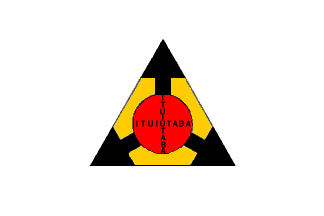 image
by Joseph McMillan
image
by Joseph McMillan
Last modified: 2012-03-17 by ian macdonald
Keywords: minas gerais | ituiutaba |
Links: FOTW homepage |
search |
disclaimer and copyright |
write us |
mirrors
A white flag with a large triangle made up of three black arrows on a yellow base. Over this is placed a red disk bearing the name ITUIUTABA vertically and horizontally.
The municipality of Ituiutaba (97,171 inhabitants in 2010; 2,598 sq. km) is
located in the "Mining Triangle" (southwestern Minas Gerais), on the border with
Goiás, 680 km of Belo Horizonte.
Ituiutaba emerged in 1832, as Arraial de
São José do Tijuco, with the building of a chapel. The parish was founded in
1839 but the settlement of the place started only in 1882, the
first colonist being Pio Augusto Goulart Brum. The early town was designed in
1883 by Father Ângelo Tardio Bruno João Gomes Pinheiro, who built houses,
bridges and plantations. The municipality of Vila Platina was established by
State Law No. 319 on 16 September 1901, and renamed Ituiutaba on 25 April
1917.
The flag of Ituiutaba is prescribed by Municipal Law No. 3,094
of 8 December 1994. The flag was designed in 1969 for the presentation of
the town in a program of the TV channel "Itacolomy" (Belo Horizonte). It was
manufactured by Ms. Júlia Diniz and Geralda França Ribeiro, using a draft
proposed by the Mayor Álvaro Otávio Macedo de Andrade and the teacher Ester
Majadas de Araújo. The analytic description of the flag was elaborated on 13
April 1992 by the architect Hygino José Ferreira Neto.
Analytical
description.
The flag is rectangular, white, made of 150 units in width on
100 units in height. In the middle of the flag is a yellow equilateral
triangle of 56 units in side, with one of its sides parallel to the base of
the rectangle, inscribed with a centered red disc of 15 units in radius.
The angles of the triangle form three stylized black arrows, separated from
each other by a space of 1 unit [?] in width and converging into the centered
red disc of 15 units in radius. Inside the centered red disc is placed the
writing "ITUIUTABA", set vertically and horizontally to form a cross, the
fifth letter ("U") being placed in the center of the disk. The width and the
height of the word "ITUIUTABA" is 22 units. The letters are black, 2 units in
height. In the horizontal writing, the letters are spaced of 1.3 units left
of the central "U" and 0.5 units right of it; in the vertical writing, the
space between the letters is 0.5 units.
Cultural meaning.
White. An
old symbol used on flags, reflecting deep historical roots. The white color,
as the sum of all colors, symbolizes the union of all races.
Yellow. The
color of (mature) gold, symbolizing wealth due to gold washing in river
Tijuco in 1939-1940. It also means that Ituiutaba is a mature town.
Red.
In our flag, meaning dynamism and progress without limits.
Black. The sweat,
the struggle and the work of the inhabitants.
The name "ITUIUTABA" in a cross
pattern recalls the historical mission of the Christian founders. "Brazil
has the shape of a heart... an emblematic cross - The Southern Cross
recalling in the sky the historical mission, with wide open arms and
hospitality. Ituiutaba is in the heart of Brazil." (Senator Camilo Chaves)
Etymology
"I"; River
"Tuiu": Tijuco
"Taba": Settlement
http://www.ituiutaba.mg.gov.br/?c=resposta&loc=31&t=Bandeira&ca=3&i=31 -
Municipal website
Ivan Sache, 5 February 2012